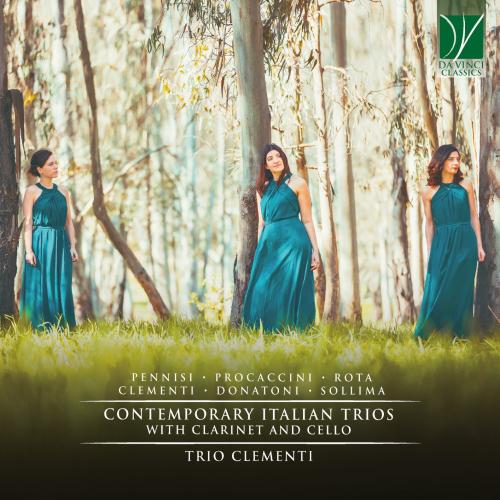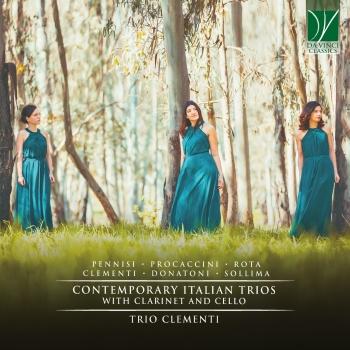
Pennisi, Procaccini, Rota, Clementi, Donatoni, Sollima: Contemporary Italian Trios with Clarinet and Cello Chiara D'Aparo, Vanessa Grasso, Giulia Russo, Trio Clementi
Album Info
Album Veröffentlichung:
2022
HRA-Veröffentlichung:
30.09.2022
Label: Da Vinci Classics
Genre: Classical
Subgenre: Chamber Music
Interpret: Chiara D'Aparo, Vanessa Grasso, Giulia Russo, Trio Clementi
Das Album enthält Albumcover
Entschuldigen Sie bitte!
Sehr geehrter HIGHRESAUDIO Besucher,
leider kann das Album zurzeit aufgrund von Länder- und Lizenzbeschränkungen nicht gekauft werden oder uns liegt der offizielle Veröffentlichungstermin für Ihr Land noch nicht vor. Wir aktualisieren unsere Veröffentlichungstermine ein- bis zweimal die Woche. Bitte schauen Sie ab und zu mal wieder rein.
Wir empfehlen Ihnen das Album auf Ihre Merkliste zu setzen.
Wir bedanken uns für Ihr Verständnis und Ihre Geduld.
Ihr, HIGHRESAUDIO
- Francesco Pennisi (b. 1934): Cinque pezzi infantili for Piano 4-Hands
- 1 Pennisi: Cinque pezzi infantili for Piano 4-Hands: No. 1, Marcetta (Transcription for Clarinet, Cello and Piano by Luciano Maria Serra) 01:28
- 2 Pennisi: Cinque pezzi infantili for Piano 4-Hands: No. 2, Notturnino (Transcription for Clarinet, Cello and Piano by Luciano Maria Serra) 02:27
- 3 Pennisi: Cinque pezzi infantili for Piano 4-Hands: No. 3, Valzer (Transcription for Clarinet, Cello and Piano by Luciano Maria Serra) 01:28
- 4 Pennisi: Cinque pezzi infantili for Piano 4-Hands: No. 4, Siciliana (Transcription for Clarinet, Cello and Piano by Luciano Maria Serra) 01:57
- 5 Pennisi: Cinque pezzi infantili for Piano 4-Hands: No. 5, Polka (Transcription for Clarinet, Cello and Piano by Luciano Maria Serra) 01:03
- Teresa Procaccini (b. 1934): Trio for Clarinet, Cello and Piano, Op. 36:
- 6 Procaccini: Trio for Clarinet, Cello and Piano, Op. 36: I. Allegro vivace e impetuoso 04:37
- 7 Procaccini: Trio for Clarinet, Cello and Piano, Op. 36: II. Andantino 04:33
- 8 Procaccini: Trio for Clarinet, Cello and Piano, Op. 36: III. Presto 02:42
- Nino Rota (1911 - 1979): Trio for Clarinet, Cello and Piano:
- 9 Rota: Trio for Clarinet, Cello and Piano: I. Allegro 05:24
- 10 Rota: Trio for Clarinet, Cello and Piano: II. Andante 05:23
- 11 Rota: Trio for Clarinet, Cello and Piano: III. Allegrissimo 04:36
- Aldo Clementi (1925 - 2011): Dedica (For Clarinet, Cello and Piano):
- 12 Clementi: Dedica (For Clarinet, Cello and Piano) 03:24
- Franco Donatoni (1927 - 2000): Elly (For Clarinet, Cello and Piano):
- 13 Donatoni: Elly (For Clarinet, Cello and Piano) 00:42
- Cerocchi 70 (For Clarinet, Cello and Piano):
- 14 Donatoni: Cerocchi 70 (For Clarinet, Cello and Piano) 01:43
- Giovanni Sollima (b. 1962): Voyage (Transcription for Clarinet, Cello and Piano by Giovanni Sollima)
- 15 Sollima: Voyage (Transcription for Clarinet, Cello and Piano by Giovanni Sollima) 10:31
Info zu Pennisi, Procaccini, Rota, Clementi, Donatoni, Sollima: Contemporary Italian Trios with Clarinet and Cello
The curious musicophile is always in quest of new repertoires, hidden gems and unjustly forgotten figures. This Da Vinci Classics album represents such a discovery, whose value is increased by the unusual instrumental combination it features, i.e. a piano trio with clarinet and cello.
The composer of these works is Gaetano Corticelli, a now neglected composer who was highly appreciated during his lifetime. He was born on June 22nd, 1804, to Lucia Mazzoni and her husband Clemente Corticelli, who was a famous belcanto singer and teacher at Rossini’s time. Gaetano’s younger brother, Enrico (1826-1890) would also become a pianist and an esteemed teacher at the Accademia Filarmonica.
With such a musical family it was therefore natural, for Gaetano, to undertake musical studies in his native city of Bologna. There, at the beginning of the nineteenth century, the influence of Padre Martini was still abundantly felt. This famous erudite scholar, musician and composer had taught Mozart and Johann Christian Bach; he had also accumulated an impressive collection of books and manuscripts, which he bequeathed, upon his death, to another Franciscan friar who had been his disciple, i.e. Stanislao Mattei (1750-1825). This collection formed the basis of the Library of the Liceo Musicale, thus linking the practice and teaching of music with the research and study of its sources.
Stanislao Mattei was the first teacher of counterpoint and composition at the Liceo, teaching hundreds of students, among whom Rossini, Donizetti and Morlacchi. It was normal, therefore, for a promising young musician such as Corticelli to become his student. Gaetano’s piano teacher was Benedetto Donelli (1782-1839), who had been a pupil of Mattei in turn, and who taught another great pianist of the era, Stefano Golinelli (1818-1891), who would later inherit Gaetano’s teaching duties at his death.
Corticelli was an extremely brilliant student. He obtained piano prizes in 1814 (at the age of ten) and in 1817, and was awarded a distinction in counterpoint in 1820 and 1821. He debuted as a composer at thirteen, when a Piano Concerto written by him was premiered by another fellow student of the Liceo, a girl by the name of Gaetana Calvi (1818). In the same year he wrote a Tantum ergo for male voices and orchestra, and a Symphony, whereas in 1819 he composed a four-parts gradual (Veni Sponsa Christi), which was performed on the solemn occasion of St. Cecilia’s day, i.e. one of the highpoints of the academic and religious year.
When still a teenager, Corticelli applied for membership in the most prestigious musical institution of Bologna (and probably of Italy), i.e. the Accademia Filarmonica. A report dating 1822 details the development of his admission process: “[The candidate] underwent the test prescribed by our Statutes, by composing an Antiphon and Fugue in five parts. These were carefully examined by the Class of the Masters, who unanimously approved and recommended them. They contextually declared the same [Corticelli] to be admitted in the above-mentioned Class, and ordered that his name be inscribed among the others. Later, he demanded to be admitted among the Academicians, and the votes were entirely in his favour”.
If the admission to the Academy was the official mark of recognition for his compositional skills, Corticelli was equally prized as a pianist; however, he did not undertake a career as a touring virtuoso, but seemed to favour the activity as a chamber music pianist. As is well known, however, musical Italy in the nineteenth century was dominated by opera; instrumental music, and particularly chamber music, were not in vogue and could hardly earn fame and celebrity. In spite of this, some notable performances by Corticelli are documented. ...
Trio Clementi:
Chiara D'Aparo, clarinet
Vanessa Grasso, cello
Giulia Russo, piano
Vanessa Grasso
She begins studying the clarinet under the push of her grandfather musician. In 2006 she was admitted to the "Vincenzo Bellini" Higher Institute of Musical Studies in Catania in the class of M. Carmelo Dell’Acqua. She graduated in 2011 with full marks and continued his academic study, obtaining, at the same Institute, in 2014 the degree at the end of the two-year period for the training of teachers with full marks and honors and in 2015 the qualification to teaching with full marks. At the same time she attended one-year specialization courses with maestro Calogero Palermo and various master classes with masters Patrick Messina, Manuel Jodar, Vincenzo Paci, Giovanni Punzi. She has participated in several theatrical works performing music in world premiere. She has always been involved in a conspicuous concert activity in various chamber ensembles including the Calamus Clarinet Ensemble with which she performed in Milan during EXPO 2015, in Belgium on the occasion of the clarinet festival. She recorded a disc with the singer Rita Botto and with the Sicilian Clarinet Orchestra. With the Clementi Trio consisting of clarinet, cello and piano, she dedicates herself to the classical and contemporary repertoire, also enhancing the composers of the Sicilian territory. Since 2017 she has been a clarinet teacher at the musical high school “A. Musco ”of Catania.
Chiara D'Aparo
She began studying the cello at a very young age in her hometown. In 2007 she was admitted to the cello school at the "V. Bellini ”in Catania where in 2012 she graduated, under the guidance of M. Salemi, with full marks. She carries out an intense chamber music activity that sees her part of various chamber ensembles, including the Clementi Trio, which has performed at S.C.A.M in Catania, A.F.A.M in Floridia and the Accademia Filarmonica di Messina, Concert Association of the city of Noto. Participates in numerous national and international competitions, always ranking in the first places. She also studied at the I Musici Di Parma Academy with G. Gnocchi and participated in masterclasses with R. Filippini, U. Clerici, U. Hoffman, G. Georgescu. She also frequently performs in orchestral formations, and in 2017 she also collaborated with the Santa Cecilia National Orchestra. In 2014 she graduated at the end of the two-year course for teacher training with full marks and honors and in 2015 she obtained the teaching qualification. As orchestral musician she played with internationally renowned artists such as D. Rivera, D. Rea, A. Ducros, E. Bosso, S. Bollani, S. Pagliani, C. Hartmann and M. Argherich. Currently she is improving with M ° Luigi Piovano, first solo cello of the national orchestra of Santa Cecilia. She is suitable for cello auditions in a row at the Regional Orchestra of Calabria, at the Vittorio Emanuele Theater in Messina and at the Massimo Vincenzo Bellini Theater in Catania.
Giulia Russo
She began studying piano in 2005 and in 2007 was admitted to the “V. Bellini” Higher Institute of Musical studies in Catania. Student of Prof. Maria Santina Schillaci, in 2016 she graduated in Piano with full marks and honors. In 2018 she obtained the second level Specialized Degree in Music Disciplines with full marks, honors and with the possibility of recording and printing the thesis. She has participated in numerous national and international piano competitions, reporting in all first prizes and absolute prizes. She performed in concert at the Mozarteum in Salzburg in the summer of 2014 and 2015. In September 2016 she performed as a soloist, together with the youth orchestra of the Bellini Institute, Beethoven's third concert for piano and orchestra. Since 2018 she has been part of the Clementi Trio, a chamber ensemble with a particular tonal refinement. She devoted herself to the activity of collaborating pianist for choirs and opera theater performances, a role she also held at the Massimo V. Bellini Theater in Catania. She has followed numerous master's degrees with great masters such as: Bruno Canino, Randall Benway, Violetta Egorova, Joaquìn Achùcarro, Grigory Gruzman, Gerlinde Otto, Natalia Troull, Fulvio Turissini, Benedetto Lupo, Andrea Lucchesini. Currently she attends the two-year specialist course at the Accademia del Ridotto in Stradella under the guidance of M. Aquiles Delle Vigne and the three-year specialist chamber music at the Centro Studi Musica e Arte in Florence with M. Pier Narciso Masi.
Dieses Album enthält kein Booklet









